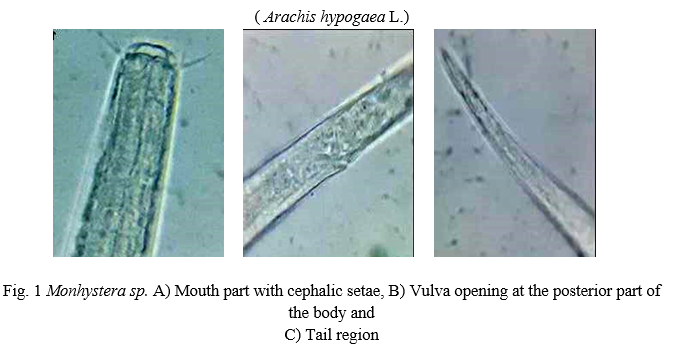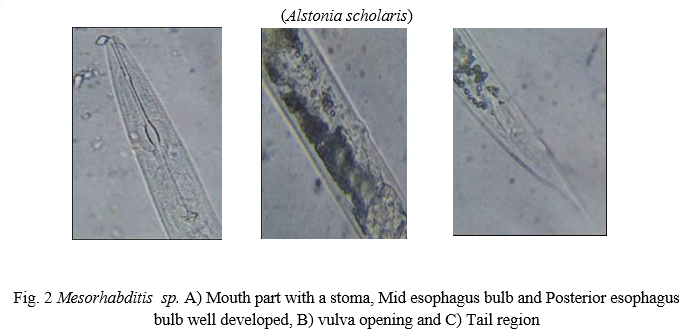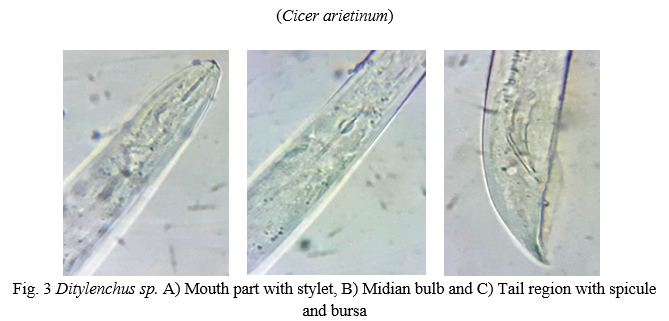Ijraset Journal For Research in Applied Science and Engineering Technology
- Home / Ijraset
- On This Page
- Abstract
- Introduction
- Conclusion
- References
- Copyright
Comparison Between Agriculture Soil and Common Land Soil in Relation to Soil Edaphic Factors and Nematode Community
Authors: Krishnaben Pankajbhai Trambadiya, Riddhi Dipeshkumar Kanabar, Manishkumar Dharamashibhai Visavadia
DOI Link: https://doi.org/10.22214/ijraset.2022.41130
Certificate: View Certificate
Abstract
Plant-parasitic nematodes may cause mechanical damage to the roots, stems, leaves, and flower structures of many plants. The host plant is more important in the nematode population. The control of these nematodes is more difficult than that of other pests because they mostly inhabit the inner part of the crops. Some Edaphic factors and secondary metabolites of plants play an important role in nematode control. The present study aims to analyze the comparision between agriculture soil and common land soil in relation to soil edaphic factors and nematode community. For testing nematode infection in crops, different agricultural fields were selected from different areas in and around Junagadh District. We have selected some agriculture sites in which nematode population were widely found. On the other hand, common land soil were no nematode population found. Edaphic factors like soil pH, Temperature, Moisture, Organic Carbon, Electrical Conductivity, Phosphorus, and Potassium were effective in the nematode growth. Results indicate that Soil temperature and Moisture were more affected in the nematode community. Further studies for the control of these nematodes are underway.
Introduction
I. INTRODUCTION
A natural population of the plant-parasitic nematodes is usually polyspecific. Species have different niche dimensions. The same species may be present in different proportions in different environmental conditions at different times. The host plant affects populations of plant-parasitic nematodes more than do soil factors. Even though the host-parasite associations are strong and the living part of a community cannot be separated from the physical part. If the species composition of populations is casual, then density-dependent factors are weak. (Norton, 1989)
Biological control of these plant-parasitic nematodes would be incomplete without some consideration of the soil environment. Plant-parasitic nematodes spend most of their life cycle stages in soil. They also develop their relationships with roots during the feeding process, it is considered them as occupying the soil–root interface rather than the bulk soil mass. Eggs of some plant-parasitic nematodes diffuse from roots and feeding takes place of the root system near root tips, root hairs, and in regions where lateral roots emerge. The bodies of ectoparasitic nematodes attach with the surface area of root; adult females of some sedentary endoparasites protrude into this zone and the eggs of many species are aggregated on the root surface. (Stirling, 2018)
Edaphic factors such as soil pH, Temperature, Moisture, Organic Carbon, Electrical Conductivity, Phosphorus, and Potassium were effective in the nematode growth (Norton, 1989). Some Edaphic factors and secondary metabolites of plants play an important role in nematode control.
The present study aims to analyze the comparision between agriculture soil and common land soil in relation to soil edaphic factors and the nematode Community.
II. MATERIAL AND METHODS
A. Study Area and Soil Sampling
This research was conducted on the different areas in and around Junagadh district which is situated in the Southwestern part of the Gujarat state. Soil samples were collected by the Random sampling method. The soil was collected from the 15 cm depth where nematode population was mostly found. Soil samples were collected in polythene bags from different sites. Each bag marked with name of the site and the date. Then soil samples were estimated in a laboratory for different edaphic factors. Based on edaphic factors we found an effect of nematode population in different soil.
B. Soil Edaphic Factors
Soil Temperature [by thermometer at a depth of 15 -20 cm below the ground]
Soil Humidity [in terms of percentage on a dry weight basis. A known amount of soil sample was taken from the different locality and it was dried in an oven at 80ºC for 48 h and weighed again. The percentage of moisture content was calculated by using the following equation:
Moisture = weight of moist soil - the weight of dry soil ×100
weight of dry soil
Soil pH [by pH meter]
Soil Electrical conductivity [by ELICO CM 183EC-TDS Analyser]
Organic carbon [by volumetric method (Walkley and Black, 1934)]
Available Phosphorus [by Bray’s and Olsen’s method (Bray and Kurtz, 1945 and Olsen, 1954)]
Potassium [by flame photometry (Toth and Prince, 1949)]
???????C. Nematode Extraction and Identification
Nematodes were found from 15-20 cm depth of soil and root materials. For that, we have used the Baerman funnel technique. The extracted nematodes were observed under a stereo microscope and Binocular light microscopes. Identification of nematodes was based on their morphological characteristics. For that, we used 2 different types of identification keys which are the interactive diagnostic key to plant-parasitic, free-living and predaceous nematodes (Tarjan et al., 1977) and the identification key for agriculturally important plant-parasitic nematodes (Mekete et al., 2012).
III. RESULTS AND DISCUSSION
Results show the statistical data for the soil analysis in and around Junagadh district and the status of the nematode population. Table-1 shows the statistical data, where the average has been calculated. In which common land soil have no nematode population found. On the other hand, agriculture soil were found to be rich in nematode populations. In which average temperature and pH were low in agricultural soils as compared to common land soils. Where as average Humidity, EC, Organic Carbon, Phosphorus and Potash were high in agricultural soils as compared to common land soils.
|
Soil Edaphic factors |
Common Land soil |
Agriculture soil |
|
Temperature (?C) |
29 |
25 |
|
Humidity (%) |
22 |
26 |
|
Soil pH |
8.1 |
7.7 |
|
Electrical Conductivity (EC) (dS/m) |
0.25 |
1.11 |
|
Organic Carbon |
0.87 |
1.95 |
|
Phosphorus (kg/ha) |
41.56 |
52.02 |
|
Potash (kg/ha) |
276 |
459 |
Table I : Stastical data of soil edaphic factors in agriculture soil and common land soil
???????A. Classification of Nematode
In our study, We have identified 4 nematode species viz., Monhystera sp., Mesorhabditis sp., Ditylenchus sp. and Meloidogyne sp. from agriculture soil rich in amount. The classification and general characters for each nematode species are as follows:
???????B. Monhystera sp. Identification
Body mostly tapering considerably posteriorly. Caudal sucker small, somewhat pointed. Esophagus uniform, cylindrical. Vulva about a posterior third of the body. Uterus unsymmetrical. Viviparous or oviparous. Spicules long. (Bastian, 1865). With the above characteristics, the collected specimen was identified by an Interactive diagnostic key to nematodes (Tarjan et al., 1977).
Classification :
Kingdom : Animalia
Phylum : Nematoda
Class : Adenophorea
Order : Monhysterida
Family : Monhysteridae
Genus : Monhystera
Species : Monhystera sp.
Host Plant : Ground nut

???????C. Mesorhabditis sp. identification :
Relatively small nematodes. Lips lobate, strongly cuticularized and in some species, deeply incised. Stoma long and narrow, never prismatic. The anterior part of esophagus is marked with transverse ridging; a median bulb present. No definite oesophageal collar. Vulva posterior and ovary single; female tail conical shaped. Bursa open and not radially arranged. Spicules long and slender, proximally knobbed, distally fused. 2 pairs of preanal papillae (Osche, 1952). With the above characteristics, the collected specimen was identified by Interactive diagnostic key to nematodes (Tarjan et al., 1977).
Classification :
Kingdom : Animalia
Phylum : Nematoda
Class : Chromadorea
Order : Rhabditida
Family : Rhabditidae
Genus : Mesorhabditis
Species : Mesorhabditis sp.
Host Plant : Saptaparni

???????D. Ditylenchus sp. Identification
Median bulb with or without valve; isthmus not separated from glandular bulb by a constriction; glandular bulb short or long, when long may overlap the intestine for a short or long distance. Ovary short or long, sometimes reaching esophageal region and/or flexed; oocytes in one/two rows; columned uterus with four rows of four cells; post-uterine sac (PUS) present or absent. Testes usually without flexures; caudal alae leptoderan, short adanal or long, but never reaching tail end. Mature female not or slightly swollen. Mycetophagous or parasites of higher plants, found in soil or above ground. (Thorne, 1945) With the above characteristics, the collected specimen was identified by an Interactive diagnostic key to nematodes (Tarjan et al., 1977).
Classification :
Kingdom : Animalia
Phylum : Nematoda
Class : Secernentea
Order : Tylenchida
Famil : Anguinidae
Genus : Ditylenchus
Species : Ditylenchus sp.
Host Plant : Chickpea

???????E. Root-knot Nematode Identification
Cuticle not abnormally thick, annulated in all stages of the male and female. The cephalic framework of medium sclerotization; lateral sectors equal to wider than submedian sectors.
- Female: Sedentary, globose with projecting neck. No preadult vermiform female stage. Cuticle moderately thick; annulationforming finger-print like pattern around vulva and anus. Labial disc dumb-bell shaped, not detached from labial sectors. Cephalic framework and spear delicate. The excretory pore is anterior to the median oesophageal bulb, often only slightly posterior to the stylet base. Vulva and anus terminal; perineal region flush or slightly raised. No cyst stage. Eggs are not retained in the body but deposited in a gelatinous matrix.
- Male: Labial area low, not set-off, irregularly annulated. Lateral field with four lines.
- Juveniles: Second stage juveniles migratory, vermiform. Cephalic framework and spear delicate. Labial area not set-off. Late second-stage sedentary, swollen (spike-tailed). The third and fourth stages occurring within the second stage cuticle, devoid of stylet.
With the above characteristics, the collected specimen was identified by an Interactive diagnostic key to nematodes (Tarjan et al., 1977).
Classification :
Kingdom: Animalia
Phylum : Nematoda
Class : Secernentea
Order : Tylenchida
Family : Heteroderidae
Genus : Meloidogyne
Species : Meloidogyne sp.
Host Plant : Ground nut
(Arachis hypogaea L.) & Chickpea
(Cicer arietinum)

IV. ACKNOWLEDGMENT
The author would like to express an immense amount of gratitude towards the co-authors and the staff members of Bahauddin Government Science College, Junagadh. The author would like to gratefully acknowledge SHODH-ScHeme Of Developing High-quality research for its financial support in the form of a stipend.
Conclusion
From our study, we concluded that these edaphic factors are play important role in the different life cycle stages of the nematode population. We found that agricultural soils are rich in nematode population as compared to common land soil. Average Temperature and pH were low in agricultural soils as compared to common land soil. Where as average Humidity, EC, Organic Carbon, Phosphorus and Potash were high in agricultural soils as compared to common land soil due to the use of fertilizers. So these Agriculture land soil were most effective in the growth of the nematode population. The nematode diversity increased while moving from acidic to alkaline pH and in abundant to phosphorus, Potash, Organic carbon.
References
[1] Bastian, H. C., II. Monograph on the Anguillulidæ, or Free Nematoids, Marine, Land, and Freshwater; with Descriptions of 100 New Species. Transactions of the Linnean Society of London (1865), Vol. 25(2), Page no. 73-184. [2] Bray, R. H., & Kurtz, L. T., Determination of total, organic, and available forms of phosphorus in soils (1945), Soil science, Vol. 59(1), Page no.39-46. [3] Mekete, T., Dababat, A. A., Sekora, N., Akyazi, F., & Abebe, E., Identification key for agriculturally important plant-parasitic nematodes: a manual for nematology. CIMMYT, 2012. [4] Nisa, R. U., Tantray, A. Y., Kouser, N., Allie, K. A., Wani, S. M., Alamri, S. A., Alyemeni, M. N., Wijaya, L. & Shah, A. A., Influence of ecological and edaphic factors on biodiversity of soil nematodes (2021), Saudi journal of biological sciences, Vol. 28(5), Page no. 3049-3059. [5] Norton, D. C., Abiotic soil factors and plant-parasitic nematode communities (1989), Journal of Nematology, Vol. 21(3), Page no. 299. [6] Olsen, S. R., Estimation of available phosphorus in soils by extraction with sodium bicarbonate, Issue 939, US Department of Agriculture, 1954. [7] Osche, G., Systematik und phylogenie der gattung Rhabditis (Nematoda). Zoologische Jahrbücher (Systematik) (1952), Vol. 81, Page no. 190-280. [8] Prajapati Dipak, Jain Nayan and Pandya Himanshu, Soil quality Assessment of selected Agricultural and Forest Field in Sabarkantha District (2016), Vol.1, Issue 2, Page no. 29-39. [9] Stirling, G. R., Biological control of plant-parasitic nematodes, 1st ed., CRC Press, 2018. [10] Tarjan, A., & Robert, P. E., Interactive Diagnostic Key to Plant Parasitic, Freeliving and Predaceous Nematodes. Journal of the Water Pollution Control Federation (1977), Vol. 49, Page no. 2318-2337. [11] Thorne, G., Ditylenchus destructor n. sp. the potato rot nematode, and Ditylenchus dipsaci (Kühn, 1857) Filipjev, 1936, the teasel nematode (Nematoda: Tylenchidae). Proceedings of the helminthological Society of Washington (1945), Vol. 12(2), Page no. 27-34. [12] Toth, S. J., Prince, A. L., Estimation of cation- exchange capacity and exchangeable Ca, K and Na contents of soils by flame photometer techniques (1949), Soil Science, Vol. (67) Page no. 435-439. [13] Walkley, A., & Black, I. A., An examination of the Degtjareff method for determining soil organic matter, and a proposed modification of the chromic acied titration method (1934), Soil science, Vol. 37(1), Page no.29-38.
Copyright
Copyright © 2022 Krishnaben Pankajbhai Trambadiya, Riddhi Dipeshkumar Kanabar, Manishkumar Dharamashibhai Visavadia. This is an open access article distributed under the Creative Commons Attribution License, which permits unrestricted use, distribution, and reproduction in any medium, provided the original work is properly cited.

Download Paper
Paper Id : IJRASET41130
Publish Date : 2022-03-31
ISSN : 2321-9653
Publisher Name : IJRASET
DOI Link : Click Here
 Submit Paper Online
Submit Paper Online

